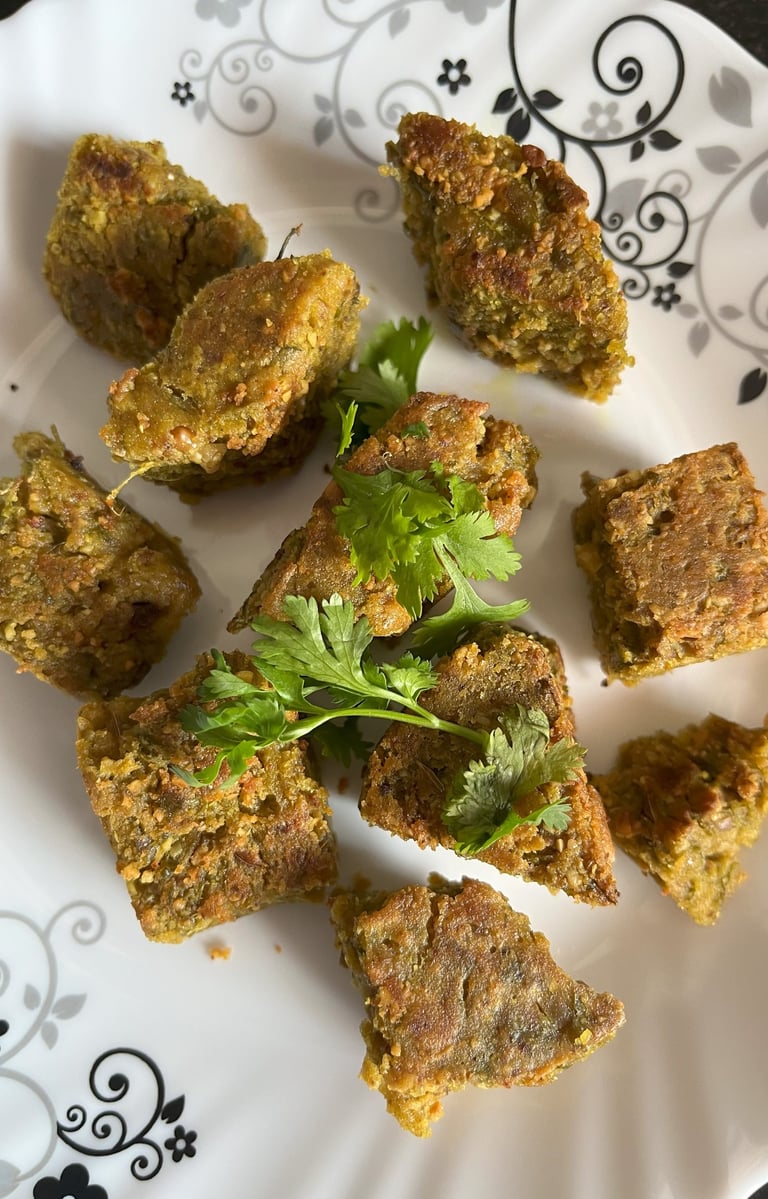Maharashtrian Delicacy with a Healthy Twist: Browntop Millet Kothimbir Vadi
Maharashtrian snack that is healthy and nutritious, made with BrownTop Millet
FOOD
Twinkle Suri
12/24/20243 min read


Browntop Millet Kothimbir Vadi is a nutritious snack hailing from the vibrant culinary landscape of Maharashtra, India. This delectable dish is primarily made from browntop millet flour, a gluten-free grain rich in protein, fiber, and essential nutrients. Alongside the millet, fresh coriander leaves play a vital role in defining the flavor profile, adding a burst of freshness and aroma. 'Kothimbir' means coriander leaves, so the dish mainly derives its flavor from this base ingredient. As a result, Kothimbir Vadi not only delights the palate but also serves as a wholesome addition to a balanced diet. This dish is often enjoyed as a snack or appetizer during gatherings, festivals, and family celebrations, making it a beloved comfort food for many. Browntop millet, a robust grain cultivated in arid regions, boasts an impressive nutritional profile that offers numerous health advantages. Incorporating browntop millet into the daily diet can provide sustained energy levels throughout the day. Its low glycemic index ensures that energy is released gradually, preventing the spikes and crashes associated with high-sugar foods. This quality makes browntop millet particularly beneficial for individuals managing diabetes or those adhering to specific dietary programs.
Its preparation involves steaming the mixture of millet flour, spices, and chopped coriander, followed by cutting it into bite-sized pieces and pan-frying to achieve a crispy texture. This delightful combination makes it a favored choice among both children and adults alike.
Ingredients:
BrownTop Millet Flour - 3/4 cup
Chickpea flour (Besan) - 1 tbsp
Roasted Peanuts - 1/4 cup
Ginger - 1 inch
Garlic - 2 cloves (or as per taste)
Green Chilis - 2 nos. (or as per taste)
Salt - as per taste
Red chili powder - 1/2 tsp
Turmeric powder - 1 tsp
Coriander powder - 1 tsp
Cumin (jeera) powder - 1 tsp
Sugar - 1/2 tsp
Asafetida (Hing) - 1/4 tsp
Baking soda - a pinch (optional)
White sesame seeds - 1 tsp (optional)
Grated coconut - 1 to 2 tbsp (optional)
Water - 1/4 cup (to make batter)
Oil - for sauteing
Preparation:
Take the roasted peanuts and grind them in the blender/ grinder into a coarse powder. If you have raw peanuts, first roast them on a medium flame till you hear the popping sounds. Cool them down and then grind them.
Take the green chilies, garlic cloves, some coriander and ginger and grind them also to form a thin paste. Roughly chop the rest of the coriander.
Now it is time to prepare the batter. In a mixing bowl, combine the browntop millet flour, chickpea flour (besan), chopped coriander, grated coconut, made paste and ground peanuts and all the spices.
Gradually add in water to form a thick, smooth batter; ensure the consistency is manageable, as it should be spoon able but not too liquid. Allow the mixture to rest for about 10-15 minutes so the flavors meld.
Take out the batter in a steel container of the desired shape after greasing the container with a little oil.
In a separate kadhai/ vessel keep the water for boiling. Place a katori/ container in the upside down position in the water. When the water is almost close to boil, keep the steel container with the batter on top of this other katori and close it with a lid on top. This is your homemade steamer and can be used for steaming the batter. Or you can just used a steamer to steam cook the batter.
Let the batter steam cook for about 15-20 minutes on low flame. You can check the end point by putting a knife in the container. If the knife comes out clean, the batter is cooked.
Take it off the steamer and let it cool for a couple of minutes. It will leave its sides and will come off easily. Take it out in a plate. Cut the steamed batter into the desired vadi shapes- rectangular or diamond.
Next, heat a pan with a little oil and add the mustard seeds. Allow them to crackle before incorporating the vadis into the pan. Once one side is cooked, carefully flip it over, allowing the other side to cook for an equal duration.
After both sides are perfectly golden brown and firm, remove the Kothimbir Vadi from the pan and let it cool for a few minutes.
Pairing it with a salad or some spicy pickles will complement the taste remarkably. This dish not only serves as a snack but can also be a delightful addition to your meals, providing a wonderful combination of texture and flavor. It can be served warm with a side of chutney or yogurt to enhance the flavor. Accompaniments like coconut chutney, spicy tomato salsa, or garlic yogurt can enhance the overall flavor profile.
Browntop millet Kothimbir Vadi can be made even more delightful through various creative variations and serving suggestions. One of the simplest ways to customize this dish is by experimenting with different ingredients. For instance, incorporating finely chopped vegetables such as spinach, grated carrots, or bell peppers can enhance the nutritional profile while adding color and flavor. Similarly, one can use other flours like ragi or jowar to create a gluten-free version, making it suitable for those with dietary restrictions. Experiment with the cooking methods by baking them for a healthier option. This technique not only reduces the use of oil but also gives the vadi a crispy texture that is equally enjoyable.
Enjoy the healthy twist on this delicious and subtle dish and elevate your taste palette to another level!


